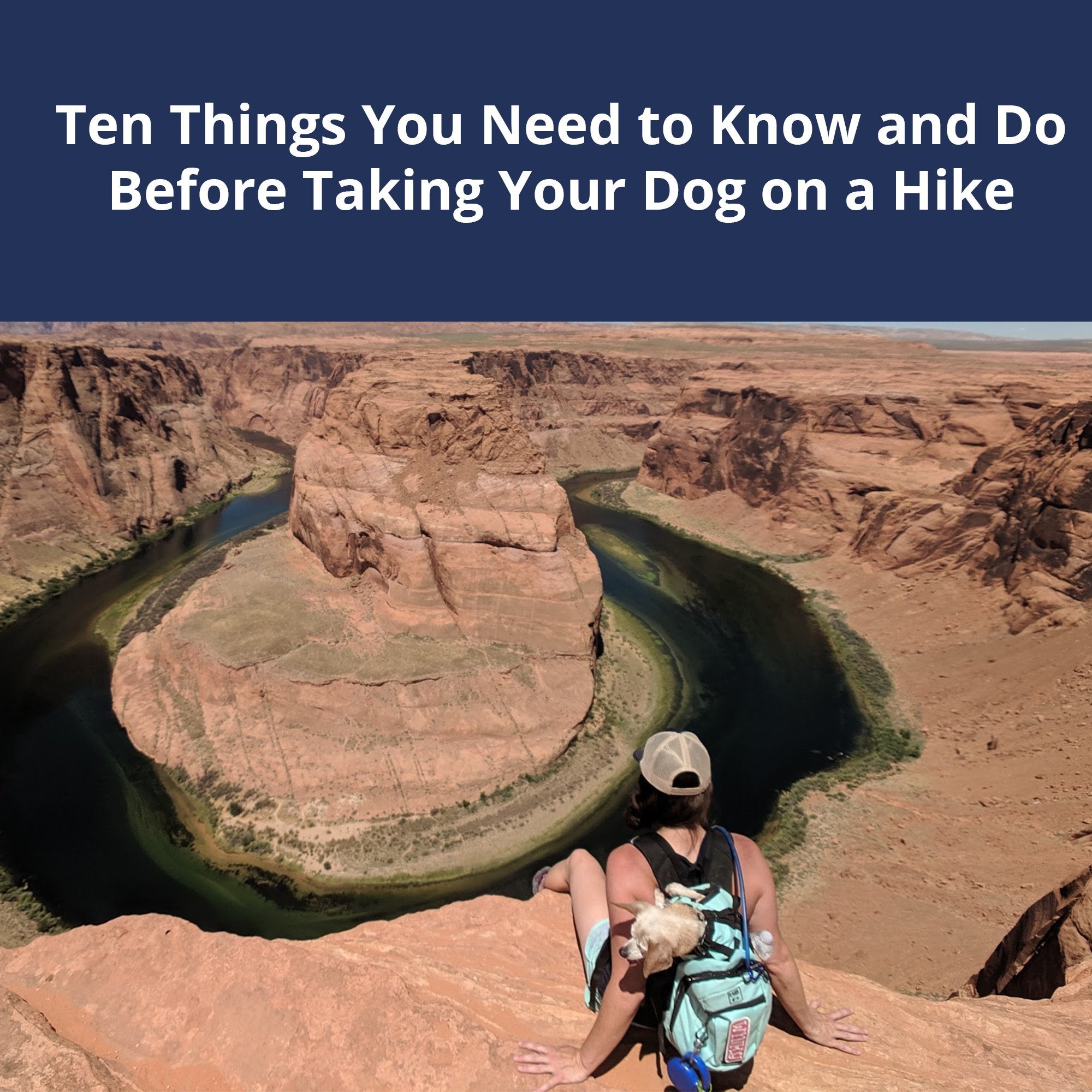Is there anything better than going on adventures with dogs? Two of my most favorite things in the world are hiking and spending time with my dog, Winky. She has been my numero uno hiking companion for the past 5 years and we’ve had more fun together than should be legal. But it wasn’t always this way. I adopted Winky when she was around 7 years old, and the hiking life was clearly a stark contrast to her former self. It took some getting used to for the both of us, and chances are you and your dog will experience a similar learning curve when you first start hiking. So before you hit the trails with your new best friend, here are some important things you need to know and do before lacing up those boots!
DO: Talk to Your Vet First
You may know your dog better than anyone, but chances are your vet has a pretty good read on them as well and in some facets they will know your dog even better than you. Is your dog a puppy or a senior? If so, then definitely seek the advice of your vet first. Just like humans, the young and the elderly are more susceptible to certain conditions. Your puppy has energy for days, a hike will be perfect for tiring them out, right? Wrong! Well, wrong-ish. Hikes can be strenuous on their still growing bodies, doing too much too soon could actually negatively impede your pups development. Also, give those immunizations some time to kick in before exposing your pup to too much. Seniors have their own set of risk factors. Winky is now in her twilight years, and I can’t imagine what we would do without our K9Sportsack. It allows her to still enjoy the outdoors and for me to still hike the trails I want. Without it, we would be very limited. Bottom line: chat with your vet about your plans first. They will probably even have a helpful pamphlet for you. Your vet will also be able to warn you about dangers in your area, which leads me to my next bit of advice…
KNOW: The Potential Dangers and Risks in Your Area
Living in Utah, most of my hiking is done in the desert where rattlesnakes are my top concern. One too close for comfort run-in with an angry rattlesnake was enough to scare me off of hiking for a couple of weeks once. My sweet old rottweiler Cinder, may she rest in peace, had no idea how close she was to being bitten, and it still makes my blood run cold just to think about it, even 4 years later.
Before hiking in any area learn a little bit about it first. What venomous snakes live there? Are there poisonous plants? Cactus? Burrs that can become embedded in your dog's coat or skin? What about wild animals, are you venturing into mountain lion or bear country? What about the terrain? Extreme weather? All of these risks need to be taken into consideration before taking your dog on a trail, after all their life is literally in your hands. Be aware and use cation, but don’t let these factors scare you off of hiking with your dog. After a couple of weeks I returned to the trails with my dogs because I realized that one run-in with a rattler didn’t discredit the countless other hikes we had been on. But you better believe I have been hyper aware of any potential dangers ever since.
DO: Have Proper Gear and Identification For Your Dog
You wouldn’t set out on a hike without adequate water and the required equipment, and your dog is no exception. So make sure you pack all the essentials for them: water, water bowl, treats or food (depending on the length of the hike), harness, name tag with your current information, rabies tag (make sure these are fastened to your dog at all times), leash, poop bags, and a doggy first aid kit. Depending on the hike, you may want to consider putting on booties to protect their paws, Winky’s K9Sportsack always gets packed, even if I plan on letting her walk this one. You’re basically packing like you’re a brand new parent leaving the house for the first time with your newborn child. Pack all the things. It’s better to have something and not need it, than need something and not have it.
I ALWAYS pack the above mentioned items when taking Winky on a hike. No matter how long or short the hike is, no matter how experienced you are, you never know what is going to happen out there, so it is important you have these essential items packed every time.
KNOW: What To Do in an Emergency
Speaking of always being prepared, before heading out on a hike take into consideration those potential dangers we talked about earlier and think about what you would do if you were to find yourself in a risky situation. Having a game plan in your mind as to how you would react to different situations could be the difference between life and death if the unthinkable were to happen. Beyond mentally preparing for the worst, there are basic safety measures you should be following everytime you hike, with or without your dog: always tell someone where you are going and when you should be back, make sure you always have your phone on you and that it is charged, carry a pocket knife, have your vet and doctor on speed dial, and if you routinely hike in backcountry, or areas with limited reception, consider investing in an emergency beacon.
DO: Build Up Your Dog’s Stamina
You wouldn’t dream of running a full marathon with zero training, so don’t expect your dog to be ready to scale 14ers right off the bat. Even when dogs seem full of endless energy, they need time to build up their stamina. Start with smaller hikes and gradually increase the distance and difficulty level. I personally think one of the best ways to monitor your dogs endurance level is by how tired they are when you finish. When you get home from a hike and your dog is immediately ready for round two, then you know they are ready to kick it up a notch.
If your dog has never been exposed to hiking, they may need some time to adjust to this new experience. When I adopted Winky it was clear she was used to the lap dog life, hiking was not her thing. However, the more we went out the more comfortable she became in this new environment and she turned into the best little hiking partner out there! In her prime she could scramble up steep rock faces, would go plowing through creeks, and always had to be the one leading the way. Your dog might not take to hiking immediately, but as you slowly expose them to this new world their instincts are sure to kick in and before you know it they will love it more than you do!
KNOW: Your Dog’s Limits and Signs of Fatigue
Dogs seem to live to make us happy, don’t they? It’s true, they will often neglect their own well being to please us, that is why it is so important for you as an owner to know your dog’s abilities and their signs of distress. Not all dogs are created equal. My two girls? Complete opposites. Cinder was my snow bunny, she loved playing in snow and was happiest when it was cold, whereas Winky is my little desert rat. She will literally go and sunbathe on my concrete patio in the middle of the summer. One time we went on a hike- easy trail, mid-60’s, sun was shining, perfect day, right? Nope. Halfway in Cinder started to pant heavily and found herself a good shady spot where she drank all the water and refused to move unless it was in the direction of the car. Meanwhile, Winky was zooming around everywhere like a sugared up child in Disneyland, she wasn’t even panting. Moral of the story: get to know your dog and what their preferences and limits are before you hit a trail.
Always closely monitor your dog when hiking. Early signs of overheating and fatigue include: increased/heavy panting, excessive drooling, unstable- they want to lie down, gums become darker, tongue hanging out, elevated heart rate. I don’t know about you, but I never even want my dog to get close to having these symptoms! So stop frequently for water breaks, if your dog won’t drink and you feel as though they are getting too hot rub some room temperature water on their chest and in their armpits. Get in some shade and just sit for a few minutes. Remember, they will give us everything they’ve got to make us happy, so we need to be the ones initiating the breaks and keeping them regulated.
DO: Teach Your Dog a “Leave It” Command
Look, you have no idea what you can potentially come across when hiking with your dog, so if your dog learns only one command in their life, make sure it’s this one: leave it! Use whatever command you want, but teach your dog that when that command is given, they are expected to stop in their tracks, no matter what distraction is in front of their face. One time my friend was hiking with his dog off leash. The dog, Winston, was running around and then he came running back to my friend… with a freaking rattlesnake in his mouth! Fortunately Winston had grabbed the snake by its neck, so it was unable to bite him, but boy, was that sucker angry! My friend, in a stroke of genius, threw a stick and Winston took off after it, dropping the stunned snake along the way. Now, my friend didn’t see Winston pick up the snake, so a “leave it” command maybe wouldn’t have been helpful; but I tell this story to stress the point that you never know when you will find yourself in a life-threatening situation where you will desperately need your dog to listen to you without hesitation. Make sure they have this command down pat.
KNOW: Leave No Trace Principles and the Rules For the Trail
Did you know that there are Leave No Trace principles for dogs as well? They are basically the same as for humans, with the exception they can usually get away with peeing wherever they want. Always pick up your dog’s business and pack it out, or at the very least, bury it. Side note, your dog isn’t the only one who needs to practice Leave No Trace. Be a team player and do your part, please always strive to leave a trail nicer than you found it!
Always respect the rules for the trail, and look them up before you go. It would suck to do all the prep work, drive a couple of hours, and then find that the trail doesn’t even allow dogs. If a trail says no dogs allowed, it is usually for a good reason, so respect the request. Some trails require dogs to be on a leash, while some will allow off leash. In today’s day and age it is pretty easy to find all of this information out with a quick google search from the comfort of your bed, so do your due diligence and read the rules of the trail before you pack up the car.
DO: Be Sure To Look Over Your Dog Before Heading Home
Before you get in the car, always give your dog a once over. Look for any cuts or injuries, check for ticks and fleas, and look for any burrs or needles your pup could have picked up along the way. Don’t forget to look in their ears, in between their paws, and up in their armpits. I also always offer Winky one last drink of water before the car ride home.
KNOW: This Is Your Dog’s Hike, Not Yours
For you, this hike is just a nice way to get some exercise and fresh air, for your dog, THIS IS THE BEST DAY EVER! Like Rapunzel getting out of the tower, best day ever level. You know those memes that have a picture of a cute pup, and it says something like “To you, they are but a small part of your life, but to them, you are their life”. I know, SOB. Big time, I can’t even type those words without getting a little teary-eyed, because it is so true! Our dog’s lives revolve completely around us, and they spend a large chunk of their life just sitting at home waiting for us. So your dog, finally gets out of the house, and it’s not just a walk, but a hike? With their favorite hooman (that’s you)? Shut the front door, this is what dreams are made of! They will want to sniff all the things. Pee on all the things. Roll in all the things. The hike will need to revolve around their schedule. Their potty breaks, their water breaks, their sit in the shade breaks. This may initially throw you off of your game a bit at first, but over time you will adapt to one another's habits and eventually you will meld together in unison and become the perfect hiking pair!
Hiking with your dog will not only bring joy to your life, but it will immensely enrich the life of your best friend as well. Follow these 10 tips and you and your pup will have many happy trails ahead of you!
If you're interested in learning the best ways to take your dog on road trips in the car, check out Best Dog Car Seats for Small and Large Dogs.














Share:
I Just Brought Home A Dog....Now What?
You Never Have To Leave Your Dog Home Alone Ever Again
7 comments
Great article with some great points; don’t take common sense for granted! Took my dog out this weekend for a hike and my wife asked me about 6-7 of these points; it is good to have answers on the tip of my mind! 8 miles, 2300 ft of elevation, and one very happy hiker cuz carrying a dirty dog sucks! He loves his K9 condo and the ability to see where I am going!
“Leave it!” One of the most important cues to teach! Thank you SO much for including it on your “10 things” list. Thanks for posting this!
Very good article. May I suggest to give extra special attention to measures for ticks, as well as hydration.
Do you do rattlesnake
Class for dogs before hand and carry anti venom?
Such a good article. I learned a ton for my next hike